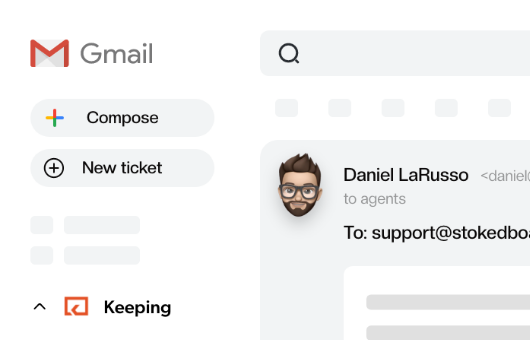
How to Improve Customer Experience
Customers who have a great experience with your company are more satisfied and more loyal - it makes the difference between an interaction that is purely transactional and one that creates delight in your customers.
Customer-centric companies have a distinct edge over their rivals who are not so customer-focused. There are many ways to prioritize your customers but one of the most popular ways is to improve customer experience.
The experience customers have when interacting with your company determines customer satisfaction and loyalty levels. Some aspects of the customer experience are outside your control but there are other elements that you can adjust to ensure customers are happier.
This means customer satisfaction is not just about price and product, although these things are important. How customers feel and how they perceive your brand is just as important, if not more important, and you have it in your ability to improve this experience.
Without a great customer experience, customer perception of your business will be lackluster. They might not be actively unhappy, but they certainly won’t favor you when it comes to choosing between your brand and a competitor.
What is customer experience?
Customer experience is the sum total of a customer’s entire interactions and perceptions of your particular brand. The customer experience is how customers feel about what your brand has to offer, and can be influenced by the experiences your business creates for your customers.
The customer experience can include engaging with your product pages, the payment process, actually using the product or service, and their interactions with customer support. It means literally any activity that a customer goes through in order to interact with your business.
The customer experience is operating throughout the customer journey and is vitally important for customer success and satisfaction, helping you to meet customer expectations.
Why is customer experience important?
Why should you even care about aiming to enhance customer experience? After all, your business has many priorities pulling you in numerous different directions. Well, customer experience is a direct predictor of customer loyalty and satisfaction. When you create a better customer experience, you are guaranteeing your business more revenue because customers stick around for longer.
Ensuring customers have a more positive experience makes your business’s reputation better. Customers feel happier about interacting with you, and they share their experience with family and friends or even their social media connections. Focusing on customer experience means your business cares about more than simply the bare minimum.
Making the customer experience better means taking care of the customer’s needs and ensuring they have no cause to complain about your business. When customers run into problems, you ensure that they can access effective and timely service that causes the issue to vanish before it becomes a major incident.
When the customer experience is great, you don’t need to worry so much about keeping prices low. Customers will seek you out for the superior experience that you provide, which translates to a higher quality service. When customers feel like you value them, they are much more likely to choose your brand over others. That’s why it’s so important to develop a strong customer experience strategy.
What are the 3 main components of customer experience?
- Success – was the interaction successful for the customer and did they achieve the goals they set for themselves?
- Effort – how easy was it for customers to complete the interaction and were there unnecessary hurdles to overcome?
- Emotion – how did customers feel when interacting with the company and what was their specific emotion?
According to Temkin, emotion plays the most significant role in determining the customer experience. How you make your customers feel when they interact with your company has a lasting impact on whether they develop customer loyalty and would be willing to recommend your brand.
Of course, you always want your customers to be successful, otherwise they are simply going to turn away from your business to an alternative solution that fulfills their needs. You need to be clear on what your customers’ goals are so that you can be in the best position to meet them.
Lowering the effort that it takes for the customer to interact with you is also a key component of the customer experience. If you hide your contact details deep within the company website, the customer is going to have to go through more effort to interact with you and this drains their morale.
What are the best five ways to improve your customer experience?
1. Offer self-service resources to help customers
Most customers would say that they would prefer never to contact customer service at all, and they would much rather solve problems themselves. Offer them the support they need to troubleshoot or find answers on their own, with self service options such as a knowledge base or video tutorials.
When customers are empowered to help themselves, they never have to wait in a queue and they can just move on with their day. This creates a much better customer experience than forcing them to reach out to your support team, and keeps them moving through the customer journey.
Customers have much less effortful experiences when they can simply consult an FAQ article if they have questions. And when you make these resources available on mobile, they can access your help on the go.
2. Reduce the time it takes to offer customer support
Customer experience goes hand in hand with customer support. Often the only human interaction a customer has with your business is through your support team, and you want to make this experience as successful as possible.
Make sure your customer service team is adequately staffed so that you can get back to customers as quickly as possible. When you avoid putting customers on hold, you can quickly offer solutions that allow them to go back to being successful with your product or service.
Adopt high-velocity channels like live chat so you can meet customers exactly where they are, and offer real-time, instant communication whenever they need it. Remember, the longer you make your customers wait, the more chance they will turn to your competitor.
3. Make the customer experience more personalized
Customers want to feel like you know who they are and that you understand their wants and needs. This level of personalization is what makes the difference between a customer experience that is merely average and one that is truly exceptional. Personalization results in a much stronger intensity of emotion because customers feel treated like an individual.
You could use a customer’s order history to make personalized recommendations for products they could try next. You can keep tabs on a customer’s previous interactions with customer service and use it to offer a more personalized experience.
When you treat customers as more than just a number, this results in a customer experience that earns you more loyalty and repeat purchases. Customers are loyal to people and experiences, rather than things. While they might be able to purchase the same product from another company, they will gradually come to have a commitment to your brand.
4. Continuously collect customer feedback
It’s impossible to improve customer experience without knowing where you stand. Sending out surveys like CSAT and NPS can help you gather qualitative and quantitative evidence about how customers feel about you and the service you have provided. Asking customers themselves to report on the experience is the best way to gather information about how you can improve.
Of course, you don’t want to bombard customers with requests for customer feedback. One of the best times to reach out to customers is just after an interaction with your company, whether that might be after a payment transaction or conversation with support.
Challenging assumptions that you make about the customer experience with honest feedback will help you to improve the level of service you are able to provide. You’ll be able to understand what you need to do more of as well as become aware of areas that are currently making your customers unhappy.
5. Empower your employees to be customer-centric
Every employee in your company – not just the customer-facing teams – should be empowered to be customer-centric. This means that every decision you make is taken with the customer at the forefront of mind, with special attention given to how it will impact the customer experience.
Employees are the ones responsible for delivering the customer experience, and are the ones that have the capability to hear and act on improvements to the customer experience. If you have a negative company culture, where employees are competitive and fearful, then you will not be able to prioritize the customer. Customers will sense your internal issues as well as the fact that your employees are not working seamlessly together.
When you focus on the customer, employees have a shared goal that orients them outside themselves. When a business values its customers, employees are happier and have their morale raised as a result. Furthermore, employees are your internal customers, so you should treat them as well if not better than you would treat your external customers.
How could the customer service experience be improved?
There are many ways to improve customer experience. You could begin by reducing the number of fields that a customer needs to complete before they can make a transaction. You could make it possible for them to save their billing details for later so it’s much easier to make a future transaction.
Any time a customer interacts with your company is an opportunity to improve the customer experience. You can audit the process that customers have to go through to obtain support, and make it easier for them to get in touch with your team. You could eliminate channels that are not very popular and focus on enhancing the service through in-demand channels such as phone and email.
Maybe you could think about making the experience of receiving your products better for your customers. You could adopt recyclable packaging so customers feel like they are benefiting the planet when they use your business. You could make the packaging more attractive so customers feel a special thrill when opening it, as well as including handwritten notes thanking them for their custom.
What makes a good customer experience?
A good customer experience will be unique to every business. There may be some common themes according to industry, such as whether you are an ecommerce business or a SaaS company. Customers have different expectations depending on what sorts of products they are buying, and may expect to have more interactions when purchasing a subscription service such as software.
A good customer experience is one where the business has anticipated customer needs and assisted customers even before they knew they needed help. Anything that results in a way to improve customer satisfaction and happiness is a valuable element to contribute to a good customer experience. Your goal should be to make customers remember you for positive reasons rather than provide a service so horrible they have to tell ten friends about it.
Ultimately, good customer experiences make customers happy. They are easy, successful and emotionally rewarding, which inspires customers to continue doing business with you. When you provide great customer experiences, customers are inclined to choose you over your competitor even if they can offer a lower price or faster delivery.
How do you fix a poor customer experience?
In order to fix a poor customer experience, you need to assemble a team that can strive to make those necessary changes to help customers. While a customer-centric culture is essential, to result in employees who can come up with ideas for improvements, you need a team that can actually drive those alterations.
While it’s great to coordinate your customer-facing teams to help fix the customer experience, even non-customer-facing departments still have a vital role to play. For example, your billing team might come up with an improvement in the billing procedure that makes customer refunds faster to process. There are many activities that contribute to the customer experience that are controlled by teams who never have any contact with your customers.
Look for areas that are causing friction or that are prompting customers to leave negative feedback. Ultimately, no customer experience is perfect and there will always be ways that your team can upgrade the experience to make customers happier.
What does a better customer experience lead to?
A more positive customer experience leads to more loyal and happy customers who spend more with your business. When you invest in the customer experience, you go beyond the bare minimum and seek out customers who actually enjoy interacting with your brand.
When you improve the customer experience, customers feel like your business exists with a purpose. You are striving to make them happy, instead of simply chasing their money. Customers feel like you value them and that you actually care about their satisfaction.
A better customer experience also results in businesses who stand out from their competitors because they offer memorable customer interactions. Buying your products is a breeze, and if customers encounter a problem the service is swift and effective.
Businesses who put special care and attention into the customer experience are on track to make more profits than businesses who do not, since it results in vastly enhanced customer retention.
What are the 5 parts of the customer experience cycle?
1. Attract potential customers
First, you must use marketing to attract potential customers who are researching solutions that match up to your business. At this point, you are working hard to make sure customers become aware of your brand and to understand the ways in which your products or services can help them.
At this stage, customers become conscious of a need or a want that they have which your brand is suited to fulfill. They will have no particular attachment to your brand and will be easily distracted by rival marketing tactics so you have to work hard to engage them.
2. Acquire new customers
Next, in the customer experience cycle you need to persuade customers to enter the funnel. This involves making sure they take actions that indicate purchasing intent. They might download an ebook, sign up to your newsletter, or book a demo. At this stage, customers are seriously considering your offering as a solution to their problem.
Depending on your industry, customer acquisition can be long or short, or somewhere in between. For B2B companies in particular the acquisition process can often take up to a year and involve many different parties.
3. Convert prospects into paying customers
Now is when you convince prospects to become paying customers. The key here is to reduce friction that might cause customers to change their mind, and make the buying process as smooth as possible. If you are an ecommerce company, you’ll need to be clear about delivery costs and your refund policy.
All the hard work you put in during the first two stages comes to fruition in the conversion stage. You need to focus on building trust with your customers so that they know they can rely on you to fulfill their needs. Reassure them that they are making the right decision in choosing your company by being explicit about your refund policy, for example.
4. Retain existing customers
Once you’ve acquired your customers, your job is not done. Arguably, retaining customers is the most important part of the customer experience cycle because it is during this stage that you will earn even more revenue. Continuing to offer value to your customers keeps them coming back, and that also means delivering top-notch support.
Don’t forget about your customers once they’ve opened their wallets. Keep communicating with them and reaching out to see if there’s any way you can help. Cross-selling and upselling is possible when you have happy customers who appreciate your products and services.
5. Build loyalty and create advocacy
Satisfied customers may not be loyal or willing to promote your business to others. They may stick around because you have the lowest price but quickly leave if they find a better offer. You need to make sure customers continue to be delighted by their experience to earn loyalty and advocacy.
For sure, advocacy is an important way to earn new business and completes the customer experience cycle. Referrals from family, friends and colleagues are trusted more than advertising.
What are 3 actions you would take to improve the customer support experience?
As we mentioned earlier, customer support is an integral part of the customer experience. When customers get in contact with you, they expect your business to provide a superior service that exceeds their expectations in every way.
Here are three actions you can take to improve the support experience:
1. Follow up with customers after you’ve helped them
When you’ve helped your customers, this might not be the end of their troubles. If you take the time to follow up with your customers after completing a support interaction this increases the chances you’ll catch and be able to solve further problems. Customers will appreciate your proactivity and willingness to assist them in any way that you can.
2. Focus on providing empathetic and human service
Instead of acting like robots, encourage and train your customer service agents in the art of delivering empathetic and human service. When you treat customers as more than just a number, this improves the customer experience and makes it more pleasurable to contact you with a problem.
3. Remove obstacles in your customers’ path
You should make it as easy as possible for customers to contact support. If your contact details are buried in your website or your customers must submit extensive details, you’re creating unnecessary obstacles in their path that prevent them from obtaining effective support.
What makes a good customer service experience?
A great customer service experience is one that leaves a customer happy and satisfied. Instead of generating badwill towards your company, customers know that you care about them and want them to be successful. Instead of rushing customers off the phone, you are taking the necessary time to get to the root of their issue and only ending the interaction when customers are ready.
A great customer service experience is determined by the customer, not the company. That’s why sending out surveys like CSAT after an interaction is the only true way to gauge customer sentiment after they have spoken to your team. It will be different for every company since every business offers a unique customer service experience.
What are the 3 most important things in customer service?
1. Speed
Customers appreciate it when you value their time. They don’t want to hang around for ages for someone to answer the phone or reply to their email. Every second their question goes unanswered is more time that they can’t spend being successful with your product. If you can also resolve their problem quickly this goes a long way to creating goodwill with your customers.
2. Effectiveness
Not only must you resolve the customer’s problem, but you must resolve it effectively. Train your agents to be skilled at diagnosing issues and applying fixes that actually work in the long-term. The customer experience is significantly enhanced if you help customers solve their problems as and when they arise.
3. Empathy
Finally, customers want to feel like you understand their problems and their needs. You need to find agents who can empathize with customers who are in difficult situations and be able to offer a humane response. When customers feel like you appreciate their circumstances, this soothes their pain and aids forgiveness.
Wrapping up
Customers who have a great experience with your company are more satisfied and more loyal. The customer experience makes the difference between an interaction that is purely transactional and one that creates delight in your customers. The customer experience requires intention and purpose to truly get it right.
And naturally, exceptional customer support is an integral part of a superior customer experience. When contacting your agents, customers are forming stronger impressions of your brand and evaluating whether your business cares about them. Investing in improvements in the customer experience ensures that customers keep returning time and time again to do business with your company.
Instead of spending every day in your business simply being reactionary, be proactive and motivated to improve the experience for your customers. They’ll truly appreciate it, and be more willing to advocate for your business to others.
Join 150+ teams that are sharing inboxes with us
The easiest way to upgrade your shared Gmail account. There’s no credit card is required.






